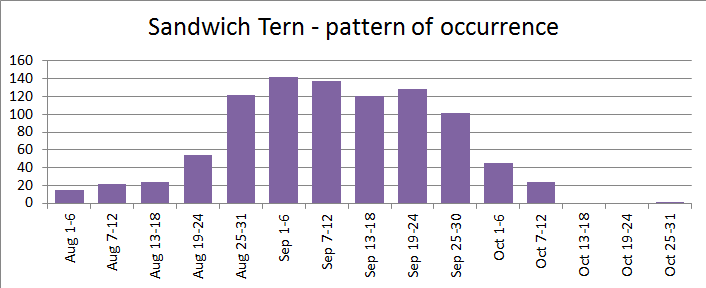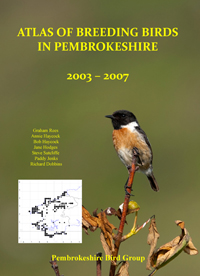Sterna sandvicensis
Autumn passage has been numerically greater than that of spring, logged between 1st July and the end of October, with 11 November sightings, the latest on the 28th. Taking the break point between spring, 30th June, and autumn, 1st July, is debatable but the latest mean June date is the 22nd and the earliest mean July date is the 9th. Peak passage has consistently occurred between the 25th of August and the 30th September. The graph shows the average no of sightings per week.

Strumble Head, mean day counts for peak period, 1980 – 2007.
The heaviest passage has been recorded along the north coast and this has been well documented at Strumble Head, where annual totals logged have varied as follows:
Strumble Head autumn totals 1980 – 2007.

Although passage birds normally moved steadily along the north coast, there have been occasional accumulations for short periods, such as 60 in the mouth of the Teifi Estuary, 42 off the Nevern Estuary, 150 in Fishguard Harbour and 250 between St David’s Head and Ramsey. Most have dispersed out to sea once clear of the Bishops but some have moved along the west coast, with up to 32 being logged at Skomer and 40 at the Gann and along the south coast up to 23 have been recorded at Tenby and Saundersfoot, with up to 40 at Wiseman’s Bridge.
The furthest recorded inland was one flying over Roch on the 21st September 1984 but they have several times been seen leaving Fishguard Harbour heading overland above Goodwick Moor. Although regularly seen inside the Cleddau Estuary, particularly at the Gann, in Dale Roads and Angle Bay, the only records from further upstream have been singles at Llanstadwell on the 9th July 1985 and 4th September 1985, two at Newton Noyes on the 2nd October 1985 and 10 at Landshipping on the 2nd October 2004 with 30 there on the 13th September 2006.
Graham Rees
(Covers records up to and including 2007).
 Tuesday, October 22, 2013 at 8:27AM
Tuesday, October 22, 2013 at 8:27AM  1949 BoP in
1949 BoP in  Sandwich Tern
Sandwich Tern 



